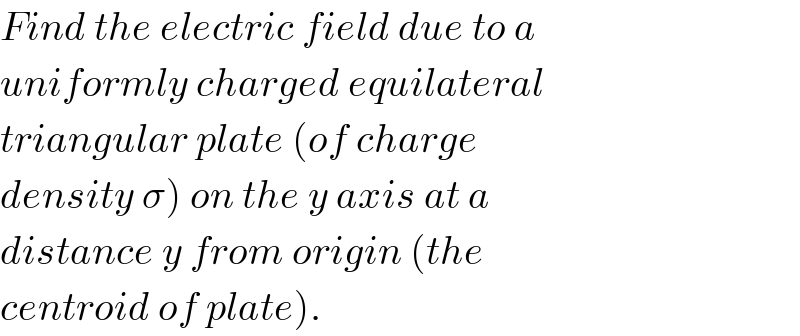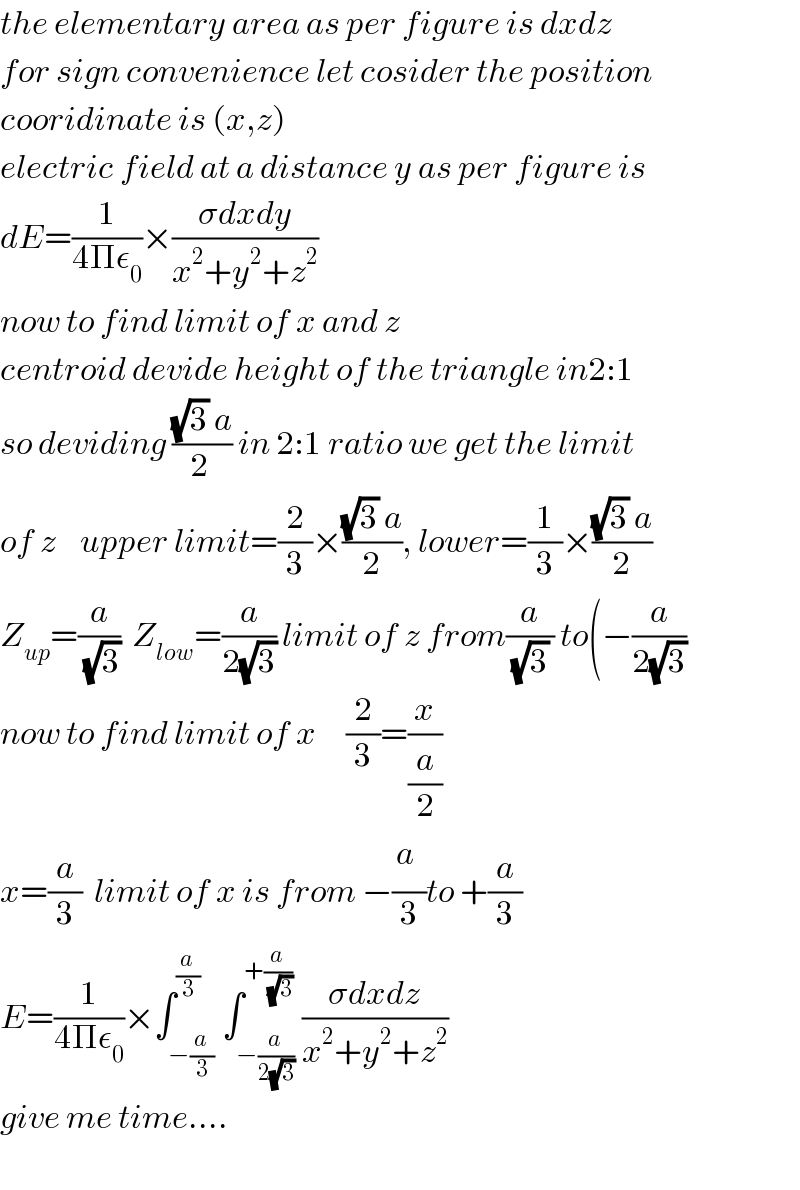
Question and Answers Forum
Question Number 35895 by ajfour last updated on 25/May/18

Commented by ajfour last updated on 25/May/18

Answered by tanmay.chaudhury50@gmail.com last updated on 25/May/18

Commented by ajfour last updated on 25/May/18

Commented by tanmay.chaudhury50@gmail.com last updated on 25/May/18

Commented by tanmay.chaudhury50@gmail.com last updated on 25/May/18

Commented by ajfour last updated on 25/May/18

Answered by ajfour last updated on 25/May/18
![dE=(1/(4πε_0 ))(((σdxdz)/(x^2 +y^2 +z^2 ))) E∣_((0,y,0)) =∫∫dEcos θ =(1/(4πε_0 )) ∫_(−(a/2)) ^( (a/2)) [∫_(−(a/(2(√3)))) ^( ((2/3)×(a/2)−x)(√3)) ((σydz)/((x^2 +y^2 +z^2 )^(3/2) ))]dx let z=(√(x^2 +y^2 )) tan φ dz=(√(x^2 +y^2 )) sec^2 φdφ E=((σy)/(4πε_0 ))∫_(−(a/2)) ^( (a/2)) [∫((√(x^2 +y^2 ))/((x^2 +y^2 )^(3/2) sec^3 φ))sec^2 φdφ]dx E=((σy)/(4πε_0 ))∫_(−(a/2)) ^( (a/2)) [∫((cos φdφ)/((x^2 +y^2 )))]dx =((σy)/(4πε_0 ))∫_(−(a/2)) ^( (a/2)) (1/((x^2 +y^2 )))[(z/(√(x^2 +y^2 +z^2 )))]_(−(a/(2(√3)))) ^(((a/3)−x)(√3)) dx =((σy)/(4πε_0 ))∫_(−(a/2)) ^( (a/2)) (1/((x^2 +y^2 )))[((((a/3)−x)(√3))/(√(x^2 +y^2 +3((a/3)−x)^2 )))+((((a/(2(√3)))))/(√(x^2 +y^2 +(a^2 /(12)))))]dx =((σy)/(4πε_0 ))∫_(−(a/2)) ^( (a/2)) [((((a/3)−x)(√3))/((x^2 +y^2 )(√(4x^2 −2ax+(a^2 /3)+y^2 ))))+(a/(2(√3)))×(1/((x^2 +y^2 )(√(x^2 +y^2 +(a^2 /(12))))))]dx =((σy)/(4πε_0 ))∫_(−(a/2)) ^( (a/2)) [((((a/3)−x)(√3))/((x^2 +y^2 )(√((2x−(a/2))^2 +(a^2 /(12))+y^2 ))))+(a/(2(√3)))×(1/((x^2 +y^2 )(√(x^2 +y^2 +(a^2 /(12))))))]dx .....](Q35905.png)
